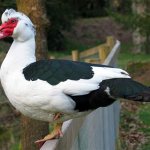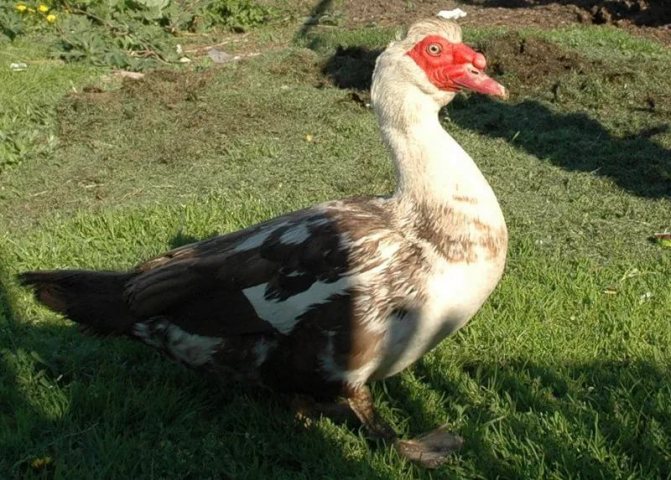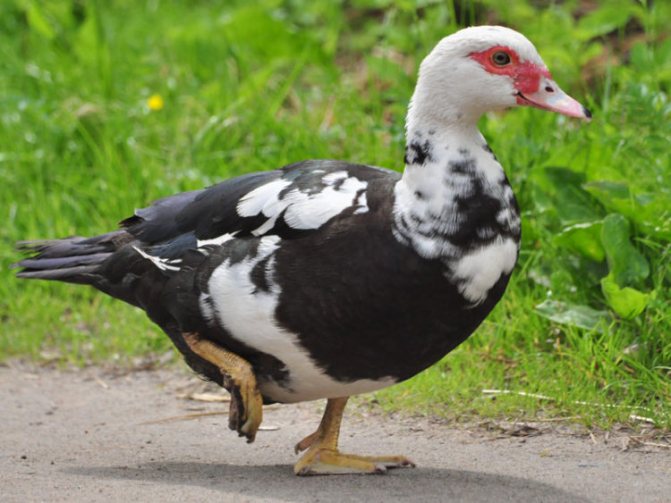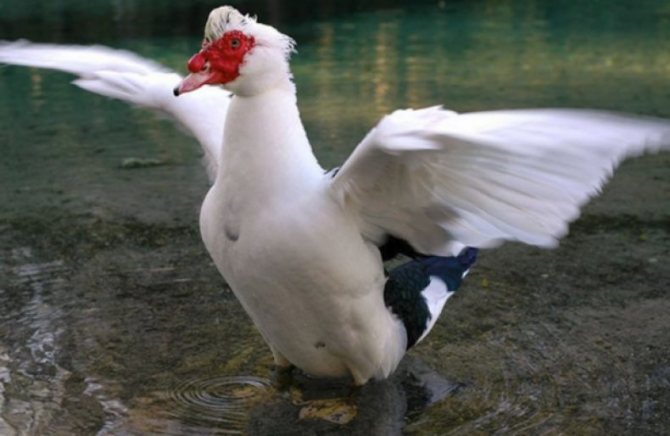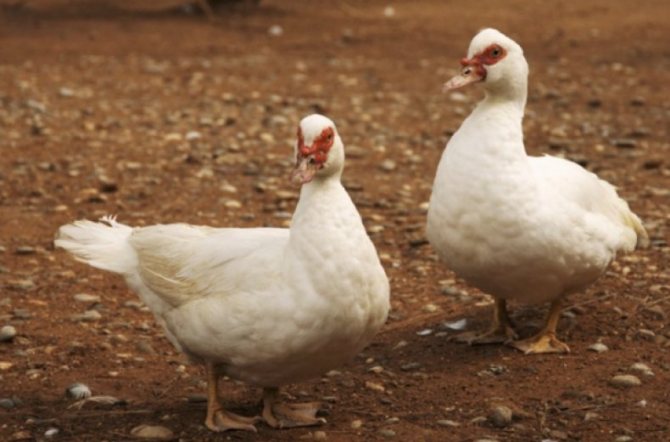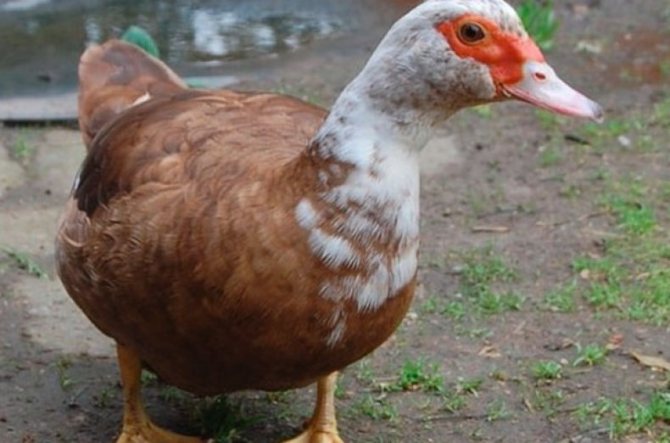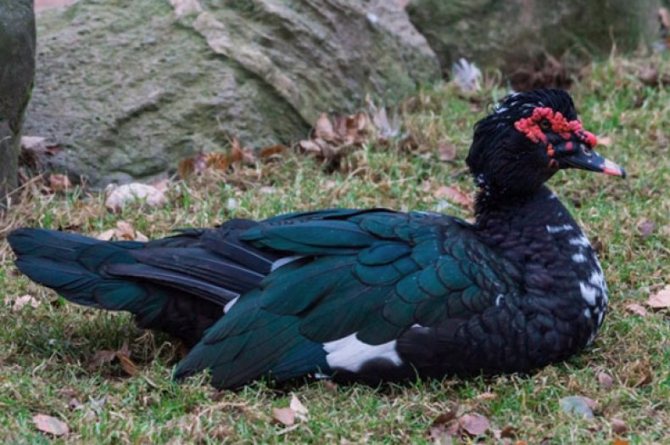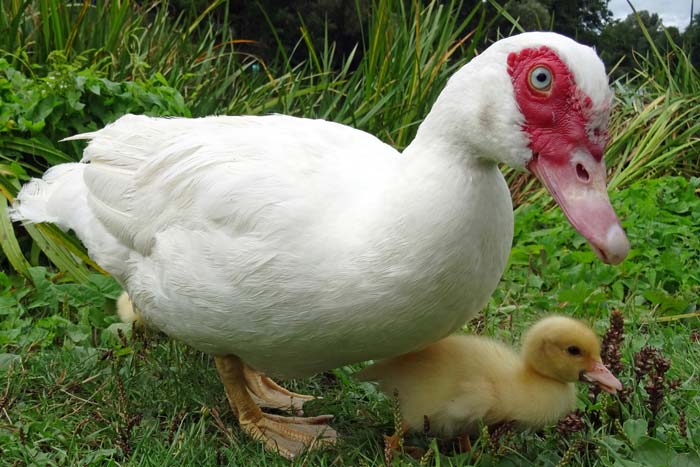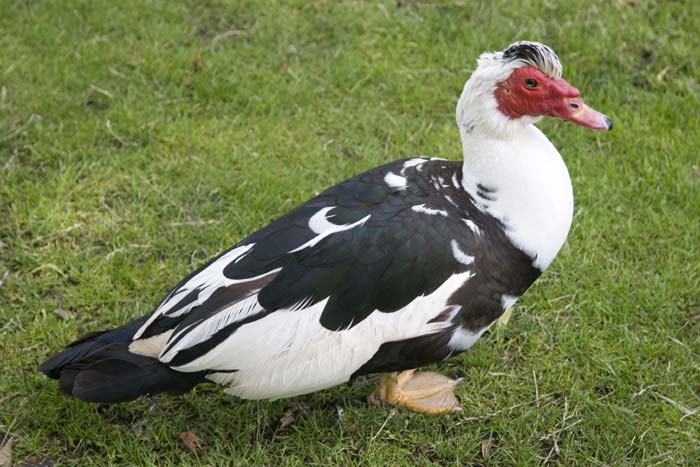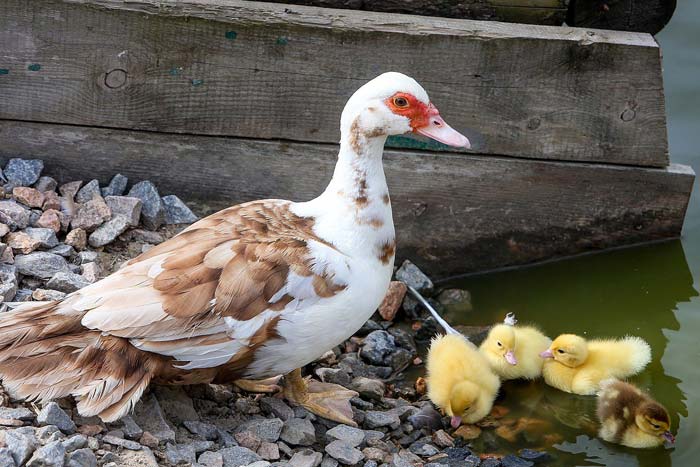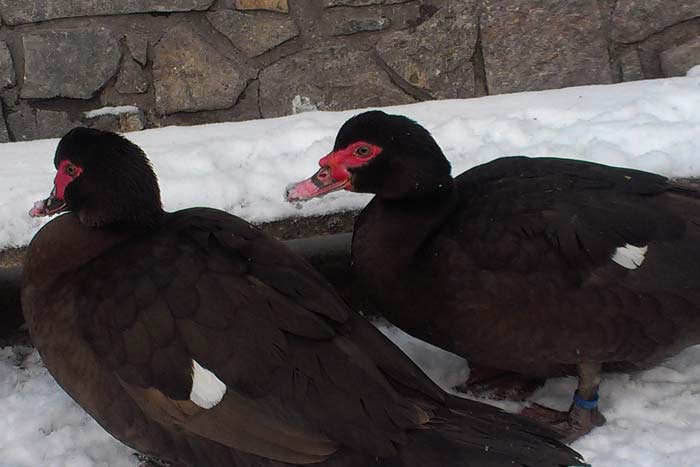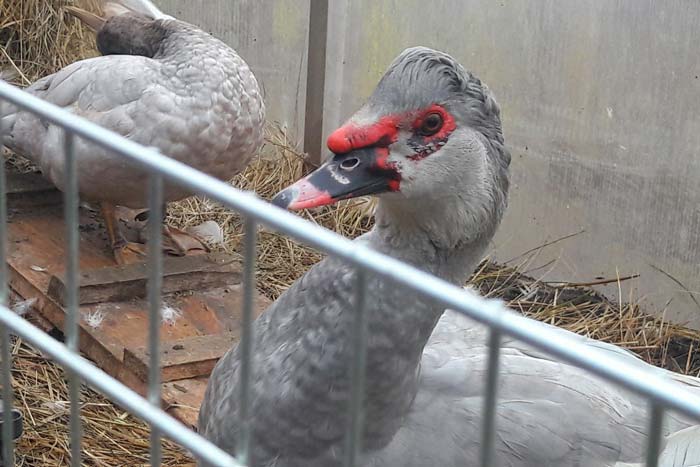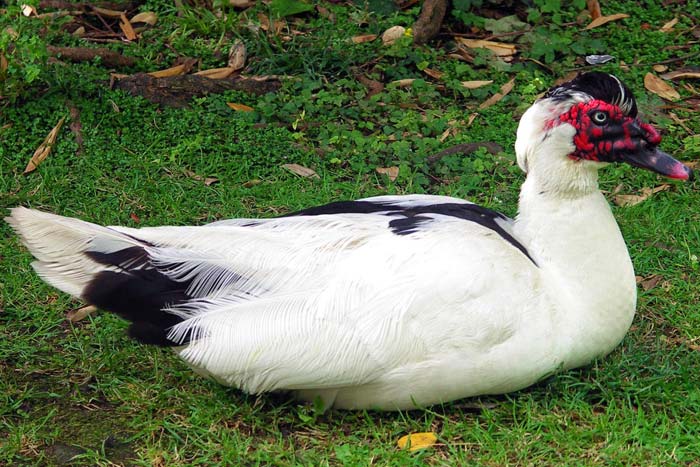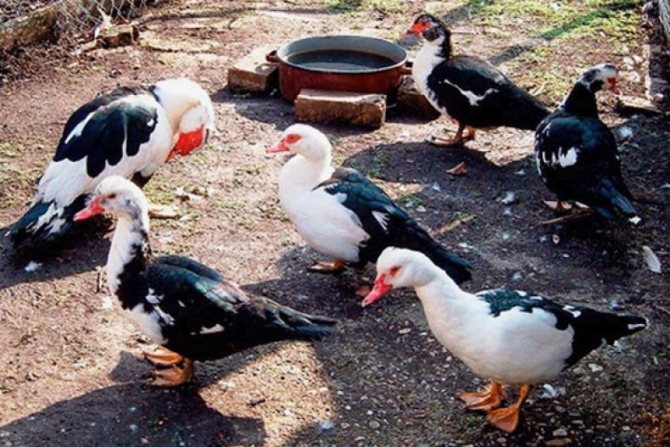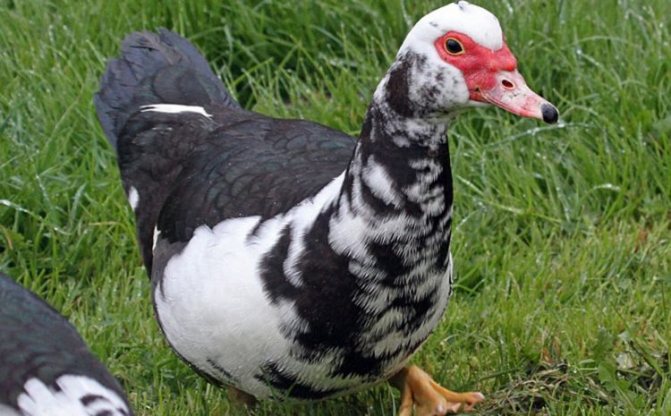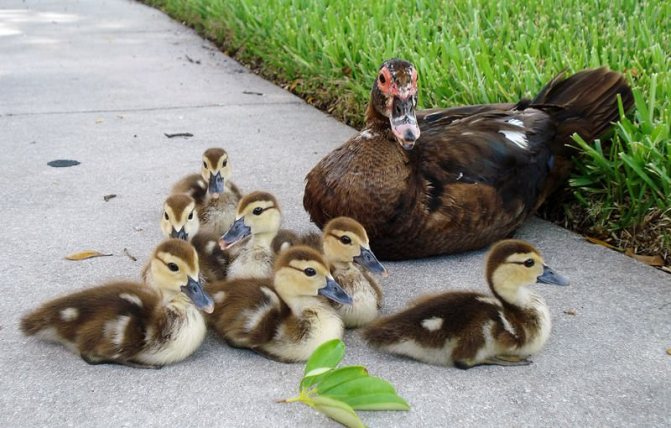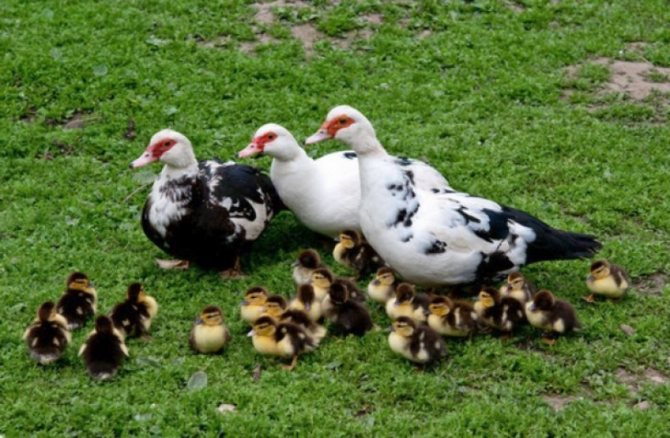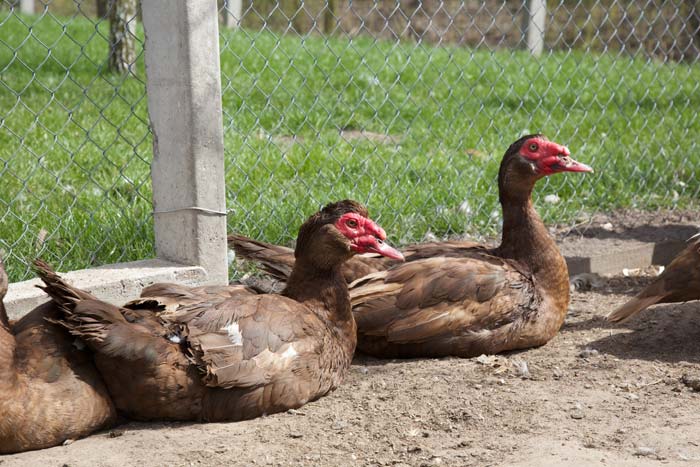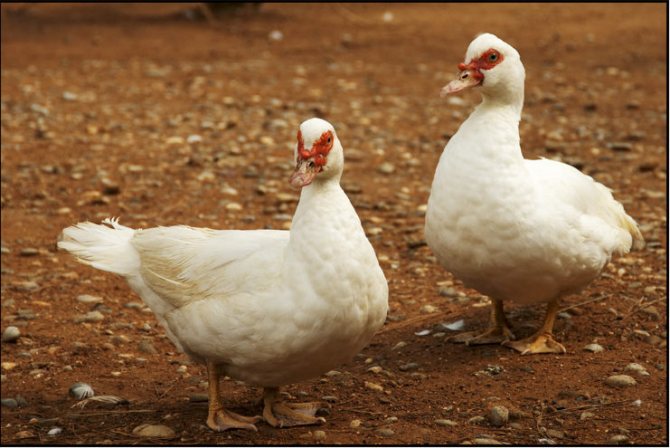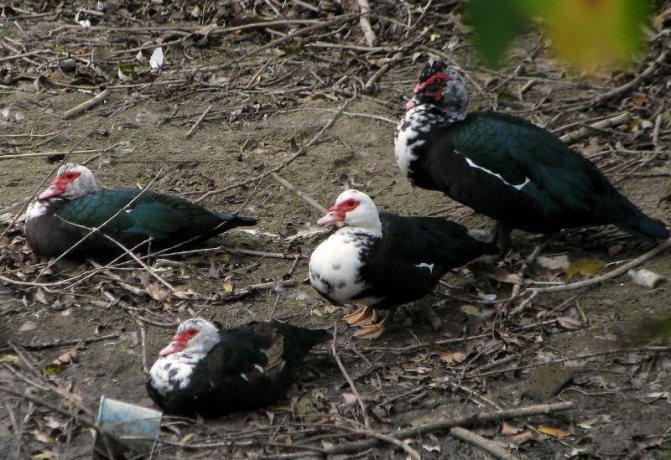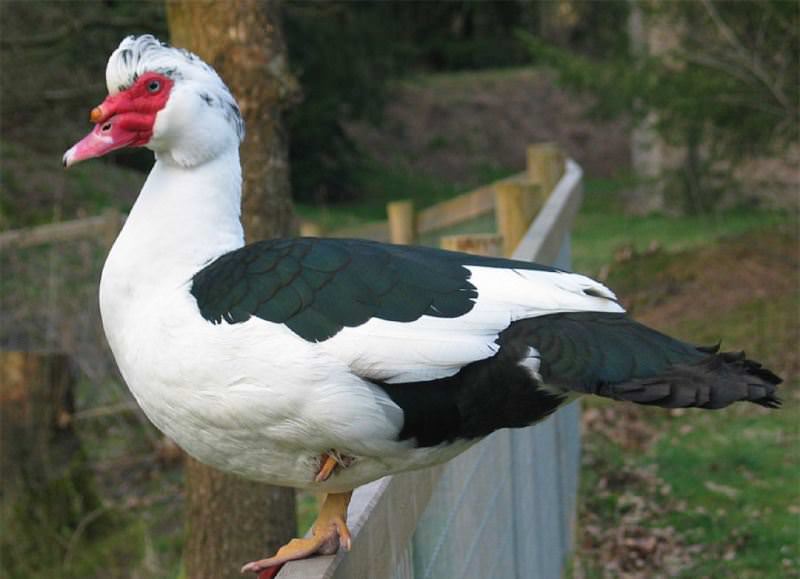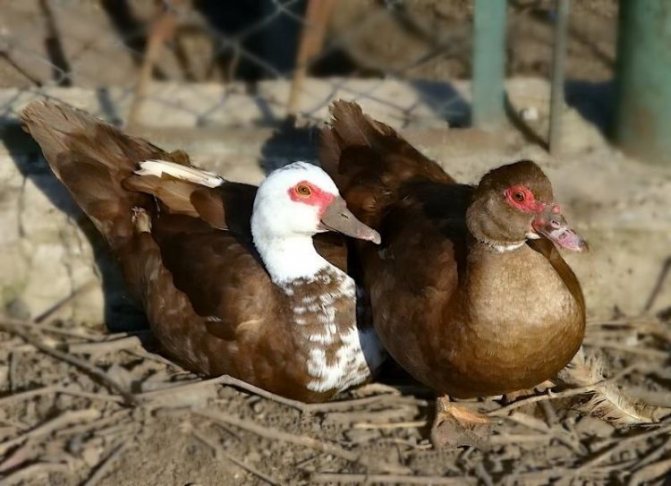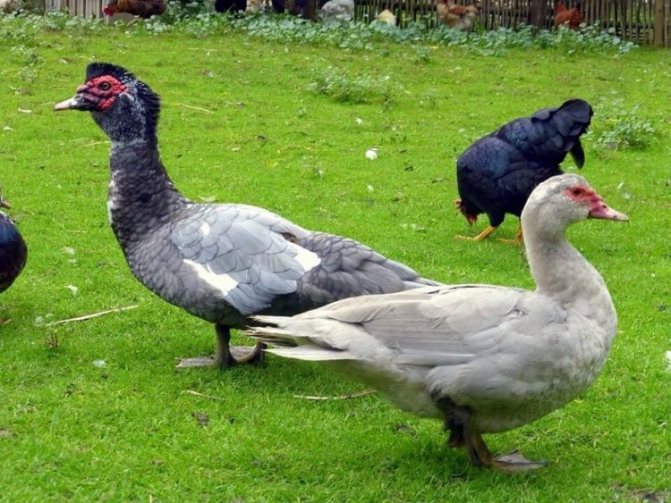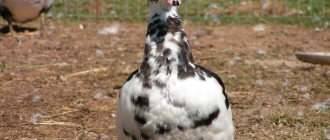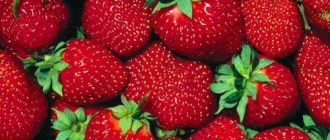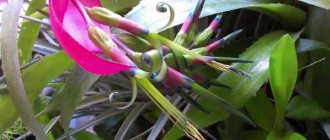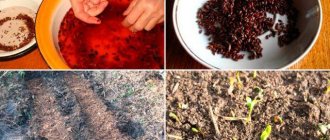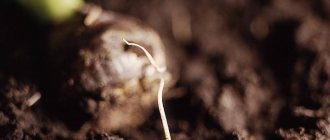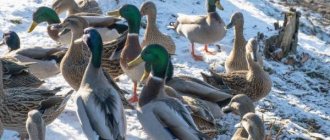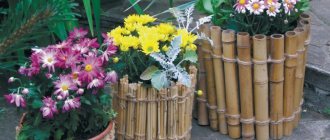In such an industry as poultry, muscovy ducks have gained particular popularity. They are also called Indo-women. This species was first bred in South America. It differs from other breeds of ducks in the appearance and quality of the resulting meat, which is lean, but tasty and enriched in protein. Meat contains balanced amino acids required by the human body. In simple terms, it is incredible healthy and tasty.
On average, a drake can reach 5-6 kg, females grow only up to 2-3 kg. Drakes make up the majority of one brood, 65-70%.
Description of the breed
Photo:
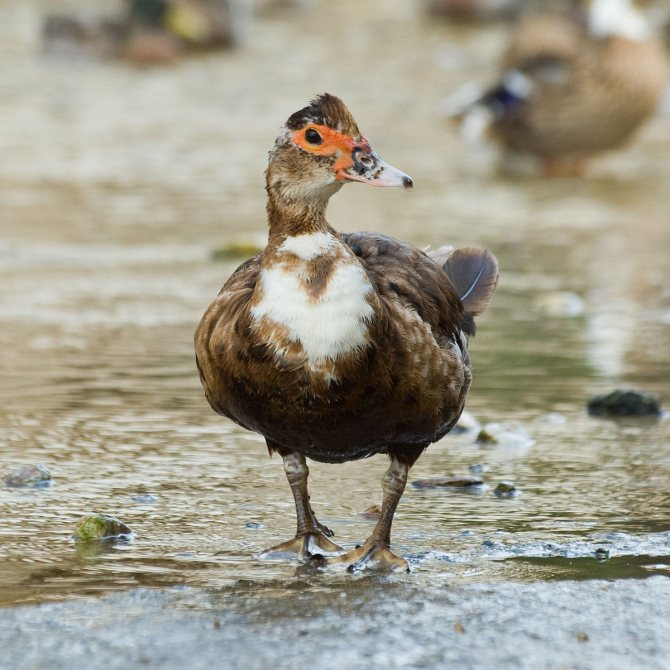
This breed comes from the wild muscovy ducks that are found in South American forests. This information confirms their desire to sit on tree branches and fly.
It is believed that these birds were tamed by the ancient Aztecs, who called them tree ducks. The musky bird got its name because of the specific smell released from the growths above the beak, which supposedly smells like real musk.
There are several types of muscovy ducks: Moscow, mute, dumb. Indo-ducks they are called because of the red-black growths growing near the beak, similar to turkey ones. Another name for birds has taken root among the people - mute, which is due to the quiet hissing emitted by birds.
Thanks to this feature, you can keep an Indoor in a private courtyard or in a country house without fear of complaints about noise from neighbors.
Physique and color
The color of musk ducks can be black, white, white-black, white with a pattern, blue, blue-white. Especially the appearance and color change when crossing Indo-Ducks with other domestic ducks. Such hybrid bird species are called mulard. Mulard chicks, regardless of the color of the female and male, are always dark.
The muscovy duck has short legs with sharp claws, a squat elongated body, a wide chest and very powerful wings with beautiful plumage. A short, thick neck topped with a rather large head.
Eyes of ducks, which are light brown, brown, gray-blue, attract attention. The beautiful iridescent feathers on the tail and wings give these ducks a special appeal. The weight of a musky duck reaches an average of 3.5 kilograms, a drake weighs about 6 kilograms.
Meat quality and taste
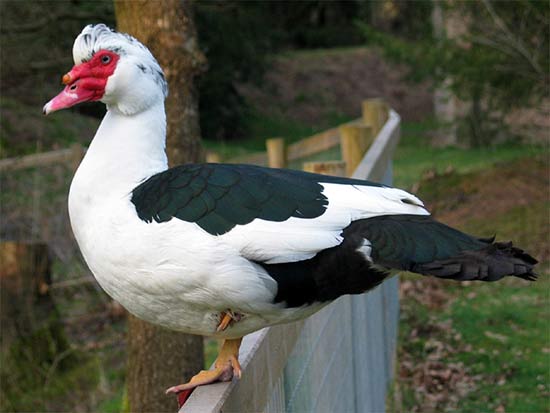

Muscovy ducklings grow up in a short time and already at the age of 3 months can be slaughtered, providing the family with tender and tasty, lean, dietary red meat.
Indo-duck was originally bred in warm regions, so they still have a genetic feature - the absence of a fat layer that protects the body from hypothermia. The fat content of meat is 25%.
The most edible part is the brisket, which weighs about 800 grams. To the taste of the Indo-duck, it resembles a game with high gustatory qualities.
The meat does not have a specific taste of waterfowl. Muscovy ducks are very popular in France, where they have long been a leader among other breeds. Indo-duck eggs are quite tasty, large, with a dense protein and a large yolk.
Character and behavior
These birds of meat breed, unlike other ducks, are calm in character and quiet. A distinctive feature of their character is equanimity.
Muscovy ducks are hardy, keep away from other birds in the yard, do not like fights. Unlike white ducks, they do not bother with constant quacking, although sometimes they make inconspicuous, quiet sounds.
Being in the company of each other, Indo-girls can kind of "hum". Interesting attractive tunes can be produced by a drake, which begins to care for a duck.
Muscovy ducks love to graze and walk in the wild, but if necessary, you can keep them in fences and cages or close them to protect them from wild animals and unforeseen events. In rural areas, owners often let Indo-girls walk freely without supervision.
Walking slowly on the carriageway and other dangerous places, they can get hit by the wheels of cars. This is especially dangerous during the period when birds are gaining weight, when their mass increases, and their speed and reaction slow down, not allowing them to escape from danger.
Muscovy ducks can fly onto rooftops or trees. The owners should not forget about this, so that their pets do not have to be collected in the neighboring yard or they do not get to the guard dogs.
The musk duck does not have a pronounced need for swimming. When breeding these birds, you do not need a pond or other body of water. They like clean reservoirs: in polluted ones they can get sick and even die.
These birds have another characteristic feature: to swallow shiny objects. It can be scattered self-tapping screws or glass shards.
Having swallowed them, the birds suffer from obstruction. Therefore, in places where Indo-women walk, it is necessary to maintain cleanliness.
Advantages and disadvantages of the breed
- The undoubted advantages of Indo-women include:
- very high gastronomic qualities of dietary lean meat;
- great meat productivity;
- calm nature and low noise of the herd;
- unpretentious maintenance;
- good immunity;
- high egg production and congenital tendency of females to incubate eggs;
- cleanliness of birds.
- Among the few shortcomings they call:
- low cold resistance;
- intolerance to high humidity in the room;
- an increased craving for pecking off everything shiny, which creates a great danger for birds if there are nails or broken glass on the ground.
Productivity and egg production
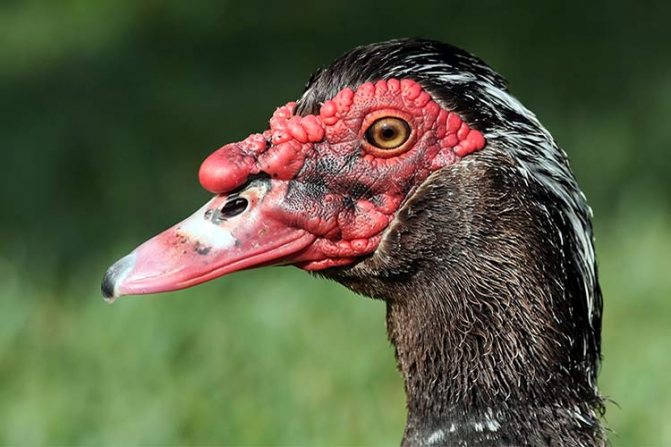

In terms of egg production, Indo-ducks are slightly inferior to white ducks, but they are good laying hens: per year, from one duck, they receive 100-110 large eggs weighing about 75-85 grams. At the age of 6-7 months, Indo-women lay eggs in cycles: they lay for about 5 months, then rest for 3 months and then lay again for 5 months.
The musk duck is picky about purity: this affects the period of its laying. The optimum air temperature for laying is + 18- + 20 ° С, but not lower than + 15 ° С.
For bedding, you can use hay, dry straw, small and large sawdust. The litter in the chicken coop should not be stale: mold and dirt will cause an outbreak of aspergillosis.
Wild type Indo-Ducks
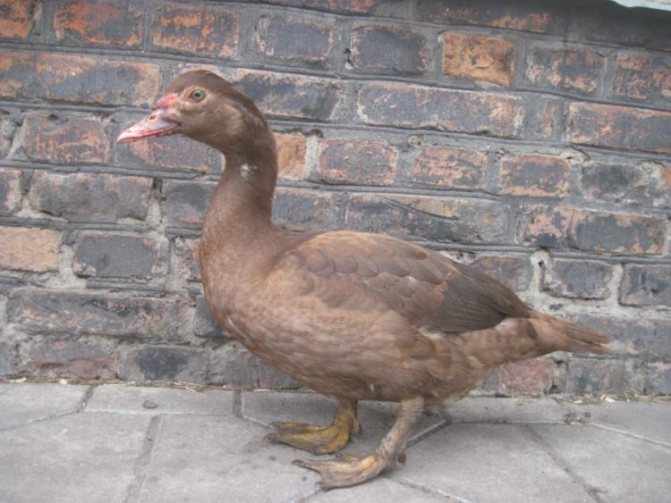

- A breed of wild blue Indo-duck.Along with the blue color, individual black feathers are visible. The color of the beak from black at the beginning turns to bright blue with a red tint at the end, the legs are black, and the eyes are brown. Live weight - 3.1-3.8 kg, egg production - 85-90 eggs.
- Wild black.The name speaks for itself, these birds are black in color, but with an emerald and purple tint. The wings, especially the tips, are white, the beak is brown. The feet are black with yellow toes. The eyes are brown. Average live weight is about 3.7-4 kg, egg production is 87-102.
- Red Indoor... Feather color of chocolate color, with here and there white feathers in the area of the wings. The beak is bright red, the legs and eyes are brown.
She is the best breed for breeding among Indo-women and has a number of advantages over others:
- very large sizes - the average weight of drakes is 5.9-6.8 kg, females - 3.9-4.5 kg;
- calm, quiet birds, endurance is well developed;
- much easier in terms of keeping and feeding in comparison with other representatives;
- high egg production - 110-125 eggs per year;
- females are excellent brooders - they are able to hatch not only their own eggs, but also the eggs of other females, as well as other species of birds;
- Practically incapable of flying, yet amenable to wing clipping procedures rather easily.
Price
The price of hatching eggs of a muscovy duck is on average 75-80 rubles per piece. Daily breeding ducklings cost 150-200 rubles per head.
Two-month-old young animals for breeding can be bought at a price of 750-800 rubles per individual.
For breeding muscovy ducks, it is recommended for novice poultry breeders to purchase day-old ducklings, and not a hatching egg. Breeding indoor dogs in an incubator requires a certain amount of experience and knowledge. A very strong shell of eggs does not allow air to pass to the embryo poorly.
By constantly turning the eggs, the hen thins the shell, which helps open the pores. In an incubator, even with regular inversion, such conditions are not easy to create.
Sales and profit making
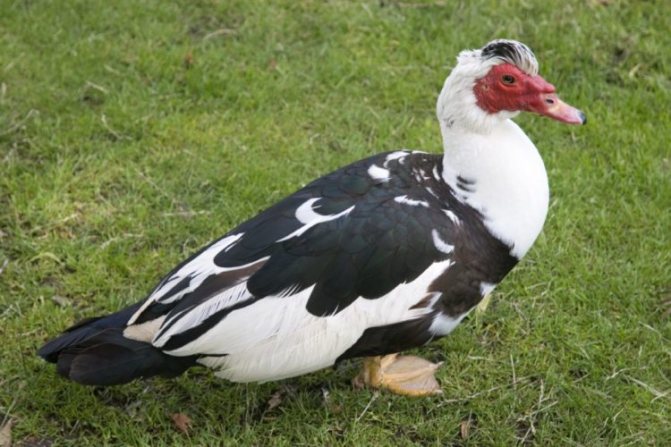

To be able to get tangible profits, it is enough to keep one hundred birds. But it's better to start with 30 birds. At the same time, one should not forget at all that the maintenance of Indo-Ducks requires one drake for every five ducks.
Indoor meat has a high taste and dietary characteristics. Given the fact that more and more people prefer buying natural products, there are no sales problems. For starters, you can sell meat and eggs in stores and markets. You can also establish contacts with restaurants and retail chains, both in your own city and throughout the region.
Nowadays, there are often cases when online stores are used to support their business, which are perfect as a showcase of goods, as well as descriptions of the terms of cooperation.
A poultry business should be planned so that every month a new batch of birds is ready for slaughter per carcass. With the right approach and a well-calculated business plan, a small household with only 100 ducks can generate $ 250 in net profit per month.
Video
Reviews of poultry farmers
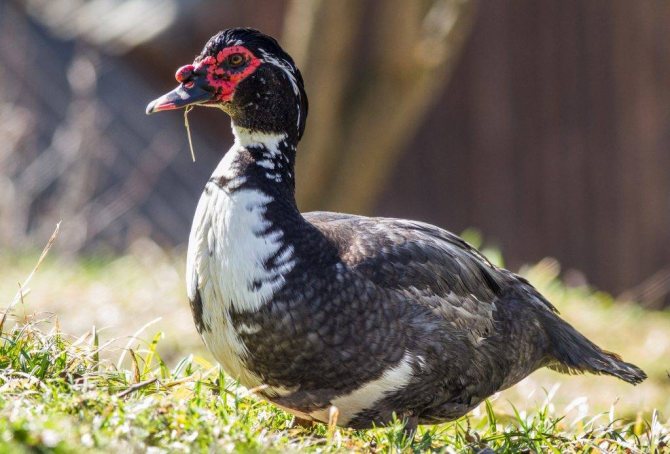

Muscovy ducks are loved by many poultry breeders who successfully raise them in their backyards. Their reviews of these birds are positive: they have no drawbacks, except for increased attention to dryness, cleanliness and temperature conditions. Many owners note the endurance of the Indo-Ducks.
In the choice of feed, they are unpretentious, rarely get sick, can do without water bodies, do not arrange noisy showdowns with other inhabitants of the courtyard.
Indoor women look very beautiful in the courtyard, even decorating it to some extent. Slowly and importantly, beautiful large drakes are pacing on the grass, in groups one by one another are quietly Indo-dots. Birds make beautiful quiet sounds that sometimes you want to stop and listen.
It is very pleasant to watch musk ducks, especially ducklings in beautiful black “caps” and “glasses”. Children can play tirelessly with funny chicks all day long.
Indoor species
The division of the Indo-duck breed is carried out only by feather color. Distinguish by color black, white, black with white wings, brown and brown with white spots. Fawn musk ducks are sometimes found. The presence of a varied color does not mean a cross between an Indo-female with other birds. So, not only plain ducks are considered purebred.
In Russia, the most common brown and black and white musky ducks. It was the ducks of this color that were brought to us from Europe. Therefore, this color is widespread.
The black and white breed usually has light brown eyes and yellow feet. White spots are most commonly found on the neck, chest, and head.White representatives of individuals are extremely rare. Their feathers do not even have the slightest shade of yellow. Their beak is pale pink, which becomes lighter at the tip. The eyes are usually blue-gray. Brown muscovy ducks with white spots have a bright red beak. The purely brown breed is usually called “red Indo-dogs”. Their feathers are chocolate-colored, the tip of the tail is always whitened. Black ducks are distinguished by the brown color of the eyes and beak. Birds with blue plumage are quite rare. They have brown eyes and a black beak.
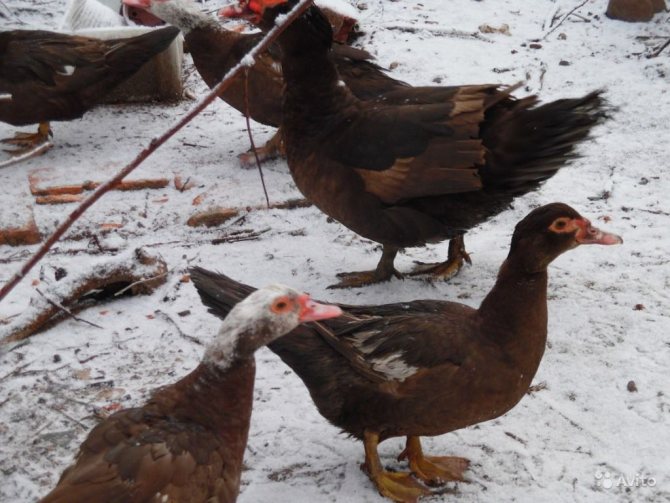

Brown Indoor
The field breed is also found. Their color is represented by a combination of several shades. Such ducks are popularly called "wild".
Maintenance and care
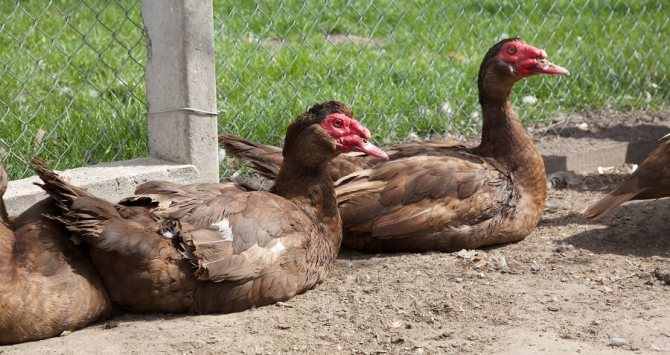

Hatching ducklings require careful grooming. Ignoring the babies, the brood hen continues to sit on the eggs. A newborn duckling is taken from under the hen in half an hour.
Without human help, the first ducklings that hatch can die of hunger or freeze.
Toddlers need to prepare a warm, heated place right away as they need care and warmth.
You need to put a warm heating pad on the bottom of the box, install a heating lamp on top. It is important to ensure that the heating pad does not cool down for a long time.
Muscovy ducklings start to eat in 2-3 days. They don't know how to do it on their own right away, so you need to help them. Chicks can grab food only in motion, therefore, crumbs of hard-boiled eggs are poured onto the backs of the chicks, which roll down when moving.
Kids catch them when they fall. The very next day, the chicks learn to eat food on their own. Eggs with undeveloped embryos are removed after 35 days of incubation.
In the evening, the warmed-up dried ducklings are again planted with the duck. In the courtyard, she will bring the chicks out in the morning, after a week they can already swim. To prevent the chicks from getting wet and drowning, a caring mother will grease their feathers with fat.
Feeding ducklings
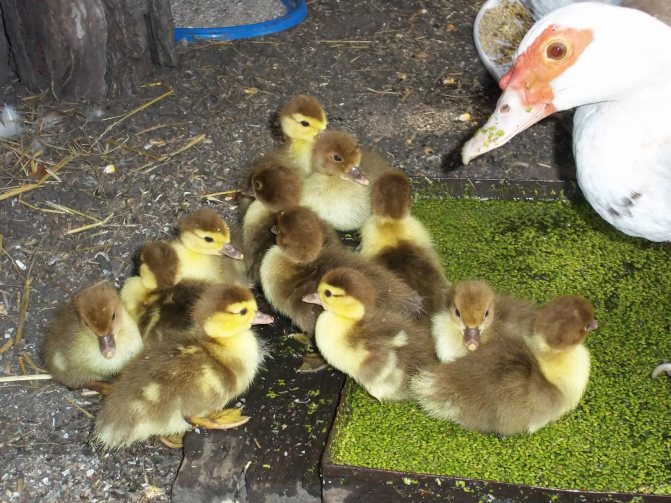

It is recommended to feed small ducklings with chopped duck or chicken eggs every 3-4 hours. Gradually, you need to add small grain mixtures in broth or milk, cottage cheese to their food. From herbs, you can give dandelion, nettle.
Already grown ducklings are gradually introduced to grain complementary foods. At first, you can give boiled grain.
Over time, the ducklings are transferred to the diet of adult ducks, which includes crushed grain, compound feed, vegetables, silage or grass. From the first day, it is imperative to give the chicks fish or meat and bone meal, vitamin and mineral supplements.
In a separate feeder, there should always be chalk, coarse gravel or sand, a shell of fine fraction. It is necessary to regularly renew and top up the water in the drinking bowls: chicks quickly die without it.
When feeding young animals for meat, it is recommended to create conditions for the rapid growth of Indo-Ducks. Feeding is economically viable for 13 weeks, or until molt occurs.
The bird losing its feather stops gaining weight. 60% of the livestock is guaranteed to be drakes, whose weight reaches 3 kilograms by 13 weeks. The livestock of Indo-Dots is transferred to winter keeping and prepared for spring brood.
Maintenance of adults
The main conditions of detention include the absence of dampness in the room and space: no more than 3 individuals per square meter. To provide fresh air access, it is necessary to equip the poultry house with ventilation (with a large number of livestock - forced).
Even in winter, Indo-women need at least half an hour of sunbathing every day. In April, by the time the eggs are laid, it is necessary, by means of additional lighting, to gradually provide them with a daylight period of at least 16 hours.
No more needed, as this can cause cannibalism towards the hatched chicks.
Muscovy ducks do not like heat. In the summer, you can keep them in a light boarding shed or shed with logs for spending the night.For winter keeping, you will need a capital poultry house protected from dampness, frost and drafts with perches and dry warm litter.
A roost for Indo-girls can be a narrow bench installed at a height of 20 centimeters from the floor and at least 30 centimeters from the wall. It is recommended to keep muscovy ducks at a temperature not lower than + 15 ° С.
For ducklings, a temperature above + 20 ° C is required.
To accommodate musky ducks at night, it is necessary to prepare a bright and clean spacious room: they do not like cramped space. Two-thirds of the area of the house should be covered with a mesh floor - the most convenient for ducks.
There should be a distance of 30 centimeters from the net to the floor. The mesh floor should be 24 x 24 mm. For the convenience of cleaning the poultry house, it is advisable to make the net freely rising.
The poultry house should be equipped with an exit to the yard for walking with an area of at least 1 square meter for 5-6 heads.
The paddock should be located so that the bird can hide in the shade from the hot sun and, in case of rain, under a canopy. Muscovy ducks with limited space are allowed to be kept in multi-tiered cages, however, this method deteriorates the taste of eggs and meat.
Feeding Indo-Ducks


On average, 160-210 grams of feed is consumed daily for the nutrition of one adult Indo-female. This is a small dose, and in comparison, for example, with the Peking duck eating much more food, raising a healthy nutmeg bird is not so expensive.
Feeding muscovy ducks should be nutritious, trying to add variety to the food. It is recommended to give them different types of grain: crushed barley, chopped corn, sowing, wheat. For the winter period, it is imperative to make stocks of herbs: dandelion, nettle, woodlice and other herbs.
It is advisable to stock up on silage: chop the grass, put in glass jars, compact, add a little salt, put an aspirin tablet on top.
It is recommended to store such blanks in the cellar.
Indo-women are especially fond of potato and Jerusalem artichoke tubers, the use of which contributes to increased egg production, rapid weight gain and beautiful plumage shine.
It is useful to add vitamins A, C, H, group B contained in food additives and premixes to the diet of Indo-duck. Herbal flour, bran, cereals, yeast, fish oil, beans, peas, greens of carrots and beets are also rich in vitamins.
In the summer period, on free grazing, Indo-dwellers get half of the food on their own. In the nearest body of water, birds can eat larvae, crustaceans, duckweed. Muscovy ducks drink a lot, so they need to provide a supply of clean drinking water all year round.
Common signs
There are many breeds of Indo-Ducks, but all are characterized by the same external data. The description of the appearance is as follows:
- large body with low strong legs;
- wide chest;
- on a medium-sized head of drakes and ducks above the beak there are red growths that look like corals.
Indo-duck species are subdivided into breeds and differ in the colors of feathers, eyes, paws and beak. The wings of all representatives are large, tightly fitting to the body. The birds feel great in the water, but in the absence of a reservoir, they adapt to the water container set by the breeder.
The character of Indo-girls is calm, balanced. They get along well with other types of poultry. Sensing danger, they do not quack, but emit a hiss, which serves to intimidate the enemy. All Indo-Duck breeds are about the same weight. The weight of the male is 6 kg, the average weight of the female varies around 3 kg.
In the oviposition of a musky female, there are from 8 to 14 eggs. Females lay 120 eggs per year. Indo-ducks by 1.5 months of age gain from 2.5 to 4 kg. The bird manifests itself as a wonderful hen, so very often breeders put eggs and other poultry under it. The diet consists of both plant and animal food.
Duck breeding for beginners
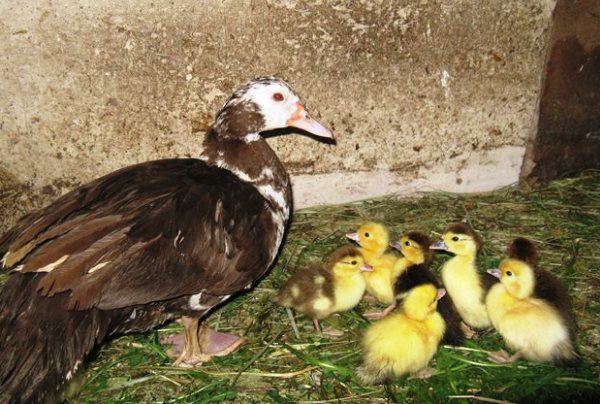

To obtain fertilized eggs, one drake is needed for 4-5 females, which are brought into a separate prepared room with secluded places and left sawdust or dry leaves.
Muscovy ducks are bred from spring masonry.
To increase the hatching percentage, eggs for hatching should be taken as early as possible, preferably in the first days of clutch.
For cultivation, it is important to select eggs that are complete in appearance: clean, of about the same weight and characteristic shape. The material for incubation can be collected within 2 weeks, stored on its side at a temperature of + 11 ° C. Ducklings hatch faster from earlier eggs.
In the case of natural excretion, the mother liquor is best separated. Eggs laid by a duck must not be touched: the bird itself knows what to do with them. Under the hen, the incubation of eggs continues for 32-35 days.
During this time, the mother duck repeatedly turns them over, sprinkles the water brought from the trough in its beak, removes the thick shell layer by layer to ensure the flow of air into the chamber. The yield from the clutch under such conditions reaches 90%.
Muscovy duck females are excellent mothers. They hatch eggs well and are very attentive to the hatched ducklings: they warm and protect them, teach them to look for food, to nibble the grass.
Little ducklings are very pleased with the mother's care, obedient, they repeat all the commands and movements of the duck. Indo-ducks and eggs of other birds, for example, chicken or goose, can hatch. Muscovy hens have a well-deserved reputation for being the best: they are able to hatch many not only their eggs, but also other birds.
During incubation of ducklings, the nest of the hen must be arranged in such a way as to prevent the eggs from rolling out. Raise the edges of the nest with a little more straw or hay so that the brood hen is slightly in the depression.
By using an incubator to breed ducklings, more males are obtained. This is good if the birds are bred for meat. The incubator is preheated to + 38 ° C and the largest eggs are placed horizontally in it first, after 5 hours - medium ones, after the same amount more - small ones.
Twice a day, it is necessary to spray the pledged material with a slightly warm solution of potassium permanganate of a slightly pink color to accelerate metabolism and cooling.
Wet eggs should be wiped with napkins in order to remove the top layer of a thick shell instead of a brooding hen. The lid of the incubator can be left open for 30 minutes to cool: the brood hen is said to have gone to eat.
Egg turning can be manual or automatic. When shifting the outermost eggs to the center, it is necessary to interchange the clutch in order to average the temperature of development.
The temperature in the chamber must be gradually reduced; when turning the eggs, observe a certain degree.
Duration of incubation of duck ducks is 32-35 days.
The resulting brood is placed in a brooder, where the care of the chicks is organized.
The first 10 days are especially critical. Gradually, the ducklings are taught to feed. You do not need to be afraid of liquid droppings: this is a characteristic feature of musky ducks chicks. Fledgling ducklings, which are bred at home without a hen, should not be allowed near the water: when they get wet, they can drown.
Appearance and features
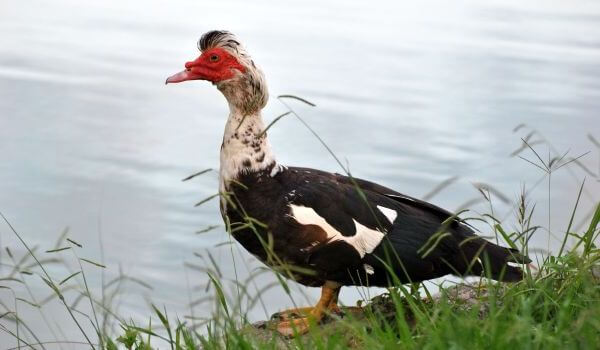

Photo: Bird Indo
The appearance of these birds may vary depending on the species. There are several types of poultry, each with a different color scheme.
Indoor women can have the following colors:
- white;
- brown;
- motley;
- black and white;
- purple;
- various shades of green;
- red.
It is worth noting that domesticated birds differ in size and appearance from wild birds. Wild ducks are about 1.5-2 times smaller and lighter than those kept at home. The average body weight of poultry ranges from 4.5 to 6 kilograms.In natural, natural conditions, birds generally have dark, muted tones. Domestic individuals are distinguished by a wide variety of bright, saturated colors.
Indo-women have characteristic external signs that are inherent only in this species of birds. They have a fairly large body and a wide, sagging chest. The body has a slightly elongated contour and an ellipse shape. Ducks of this breed have pronounced sexual dimorphism - males are much larger than females.
Birds have a short neck, and short, but very strong lower limbs, on which there are wide membranes. The limbs have long and sharp claws. Another distinctive feature can be called strong, large and tightly adjacent to the body wings.
Interesting fact: There is no fluff on the body of Indo-ducks, which is characteristic of most representatives of Anseriformes.
The birds have a small head. It has an elongated, flat beak. The eyes are small, there are red skin growths around them. They are somewhat less pronounced in females, and very clearly in males. The more pronounced the red mask in males, the higher its position and status. There is also a small feathery crest on the head.
If the bird is frightened, or feels the approach of danger, the tuft is understood and puffs up. Ducks have very thick feathers, which creates a dense, waterproof cover. This allows the birds to stay in the water for a long time.
Diseases of Indo-women and their treatment
Despite their high immunity, muscovy ducks can become infected and even die from various diseases. A disease detected in a timely manner is quite successfully treatable with the antibiotic Terramycin.
Viral hepatitis severely affects the livers of ducklings, which can lead to their death. The most effective method of combating this disease is vaccination, which is carried out twice: at one and two months of age, ducklings.
The vaccine (1 ml per bird) is given by subcutaneous injection, always prior to laying. In a dysfunctional zone, ducklings begin to be vaccinated at 3 weeks of age, after 2-3 weeks revaccination is carried out.
Why does the Indo-woman not perch?
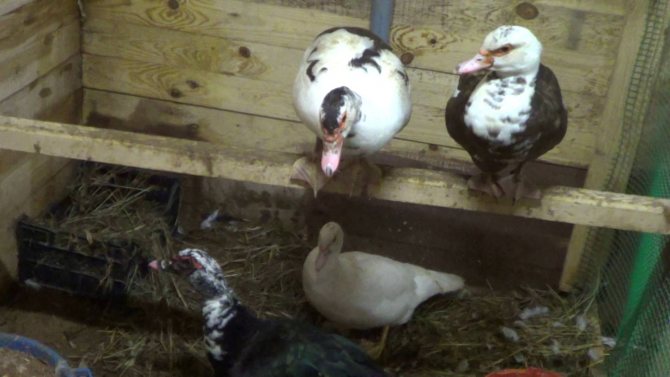

Why does the Indo-woman not perch?
Duck Agidel - breed description
There are times when a bird does not sit down to hatch offspring.
This happens if:
- the individual is very young;
- the house is in a noisy place.
The second defect is easier to eliminate. To do this, you need to move the nest to a quiet and peaceful place. Or even build several nests, and the duck itself will choose the perch to its liking. If she does not sit down, because she is young, then you need to wait it out, but in no case force her to sit down by force.
Ducklings care
Newly hatched ducklings are fed small boiled chicken or duck eggs for three days. After that, cottage cheese, a grain mixture cooked in milk or broth should be added to their feeding. Also included in the diet are herbs, nettles and dandelions.
For older ducklings, the menu is changed. Here you can already add boiled potatoes or Jerusalem artichoke. Ducklings grow quickly and gain weight on these products. Many are interested in how much an adult Indoor weighs. The female weighs between three and a half to four kilograms. The domestic male grows from five to seven kilograms. Grain must be added to the feed.
During the first days, the brood of duck should be kept warm. You can warm them up with a warm heating pad or a special lamp. Feeding can begin on the second day after they hatch from the egg. If the ducklings are led by a female, then they can be released into the reservoir on the fourth day. But incubator babies can be allowed to swim only after a month. All this depends on the development of the sebaceous glands, with the help of which the fluff of babies is covered with a special waterproof film.
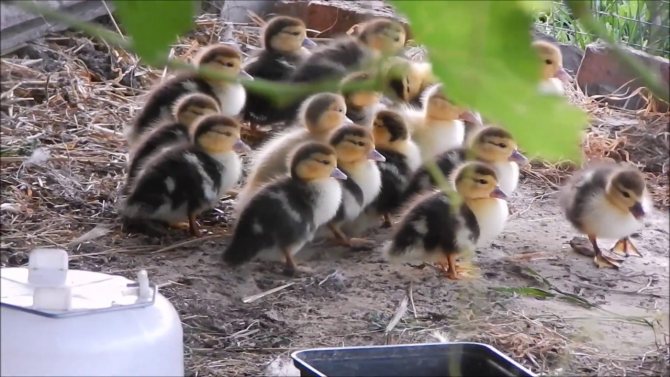

Ducklings care
Despite the fact that Indo-Ducks are considered to be birds with high immunity against diseases, it is still necessary to monitor their health.
Very often birds are affected by diseases such as:
- viral hepatitis;
- lack of plumage;
- pasteurellosis or cholera;
- aspegillosis;
- salmonellosis.
To avoid these diseases, it is recommended to vaccinate ducklings after four and eight weeks.
Feeding features
For adult ducks and ducklings, feeding is done differently. In the first three days, ducklings are given a chopped boiled egg, then they gradually begin to introduce bread soaked in milk, cottage cheese, herbs, millet. At the age of 14 days, root crops and boiled wheat grains are placed in the feeders. Sand and gravel are poured into various freestanding boxes.
If you do regular feeding with Jerusalem artichoke, weight will gain much faster. Ducks like its shoots and tubers. This food makes the plumage shiny, increases egg production. In the winter months, hay, dried branches, and vegetables are used for feeding. Forbs silage can be given. Mashed and slightly salted, it is put in jars, one aspirin tablet is placed on top and stored in the cellar.

